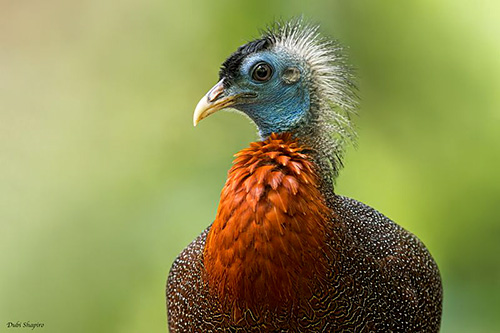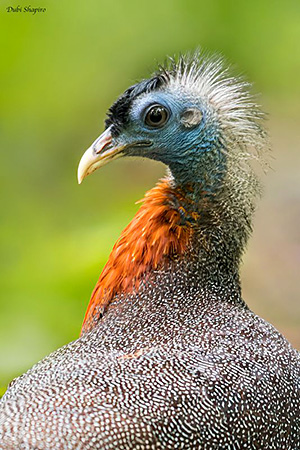
Fr: Argus géant
Ang: Great Argus
All: Argusfasan
Esp: Argos Real
Ita: Argo maggiore
Nd: Argusfazant
Sd: större argusfasan
Photographers:
Dubi Shapiro
Dubi Shapiro Photo Galleries
Ingo Waschkies
Bird Photography
Text by Nicole Bouglouan
Sources:
HANDBOOK OF THE BIRDS OF THE WORLD Vol 2 by Josep del Hoyo-Andrew Elliot-Jordi Sargatal - Lynx Edicions - ISBN: 8487334156
L’ENCYCLOPEDIE MONDIALE DES OISEAUX - Dr Christopher M. Perrins - BORDAS - ISBN: 2040185607
A Field Guide to the Birds of South-East Asia by Craig Robson. New Holland Publishers. ISBN: 9781780090498
Hennache, A. & Ottaviani, M. (2005). Monographie des faisans, volume 1. Edition W.P.A. France, Clères, France. ISBN: 2-9512467-1-4
Hennache, A. & Ottaviani, M. (2006). Monographie des faisans, volume 2. Edition W.P.A. France, Clères, France.ISBN: 2-9512467-2-2
Thai National Parks
Birdfinding.info
Wild Ambience - GREAT ARGUS - CALL & SOUNDS
Bukit Lawang - Great Argus
Bird Kingdom - Great Argus Pheasant
Rainforest Journal - Dipterocarp trees
Wikipedia, the free encyclopaedia
Great Argus
Argusianus argus
Galliformes Order – Phasianidae Family
INTRODUCTION:
The Great Argus is found in Southeast Asia, and is a native species to the jungles of Borneo, Sumatra and the Malay Peninsula where it frequents tall, dry lowland primary and logged forests.
It forages on the forest floor, searching for fallen fruits and arthropods.
At the beginning of the breeding season, the male creates an arena where it performs elaborate and spectacular courtship displays, dancing, spreading its long wings, and vibrating its plumage in front of the female. Following the copulation, the female performs alone all the nesting duties.
The Great Argus is one of the largest pheasants. It is threatened by forest destruction caused by logging, land conversion and forest fires. Hunting and trapping for cage-bird industry for the sale of the feathers are also important threats for this species.
The Great Argus is currently listed as Vulnerable.
The subspecies Argusianus argus grayi is displayed on this page.

DESCRIPTION OF THE BIRD:
Biometrics:
Length: M: 160-200 cm (tail 105-143 cm) – F: 72-76 cm (tail 30-36 cm)
Weight: M: 2000-2700 gr – F: 1600-1700 gr
The Great Argus male is a large, brown pheasant with a plumage intricately textured with fine barring and spotting. Back, rump and uppertail-coverts are pale buffy with fine black spots.
The twelve greatly elongated rectrices are more or less graduated. The central pair of rippled rectrices grows to approximately 150 cm and nearly represents ¾ of the total length of the bird, and four times the size of the outer tail feathers.
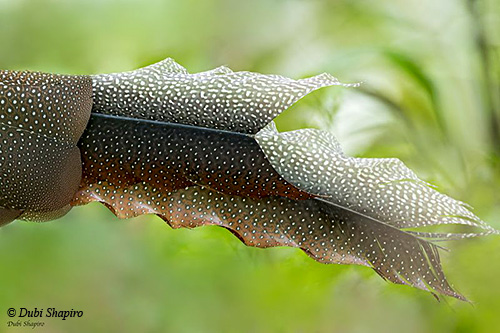
On the wings, the square-ended secondaries are longer than the primaries which appear fairly stiff. The outermost primary is shortest but becomes longer towards the innermost.
Each secondary shows a peculiar pattern, a chain of up to twenty large golden ocelli which are strongly displayed during the courtship dance. But when the bird is quiet, the ocelli remain concealed, making the plumage much duller and cryptic on the forest floor.
The small, naked head and the foreneck are blue with a black, shaggy crest. On hind crown, nape and hind neck, the pale grey feathers are often erected too.
Lower neck and breast are rufous-brown.
The bill is whitish to pale horn.
The eyes are greyish-brown, surrounded by blue, naked skin.
The strong legs and feet are pink.
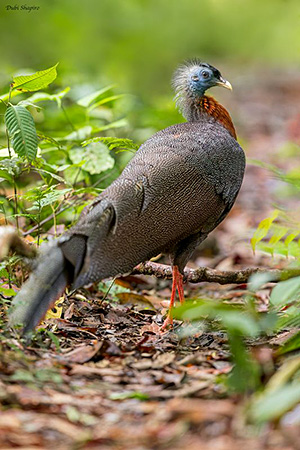
The female (not displayed) is smaller. She has similar blue head, but the crown is browner.
On the wings, the ocelli pattern is absent. The tail is much shorter and on the wings, she lacks the long secondaries.
Her plumage is brown with fine pale spotting. Neck, upper breast and upper mantle are rusty, like the outermost primary flight-feathers.
The juvenile resembles adult female but it is more reddish.
The young male gains the adult plumage in the 3d year, and the wings increase soon, and then, with each moult until 6-7th year.
The Great Argus, unlike other Galliformes, lacks the oil gland named “uropygial gland”.
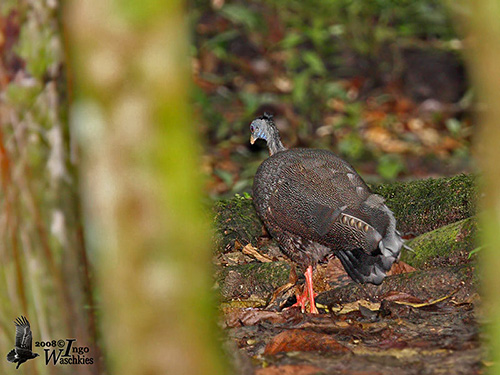
SUSBSPECIES AND RANGE:
The Great Argus has two subspecies.
A.a. argus (described above) is found in Sumatra and the Malay Peninsula.
A.a. grayi (displayed) is found in Borneo.
This one is slightly smaller and greyer than nominate. The upperparts are reddish-brown and show whiter spots (mostly brown or buff in nominate). Both breast and back are rufous-brown.
The female “grayi” has brighter rusty neck and breast, whereas the underparts are paler brown.
HABITAT:
The Great Argus frequents tall, dry lowland primary and logged forests, from sea-level to 950 metres of elevation.
In Borneo, the subspecies A.a. grayi is most abundant in primary forest, but also in old secondary forest.
In Sumatra, the nominate race prefers undisturbed forest and is rarely found in other type of habitat.
In the Malay Peninsula, it frequents mainly the tall logged forest and the unlogged primary dipterocarp forest. (The dominant tree species are of the family Dipterocarpaceae. These trees can grow very tall and large.)
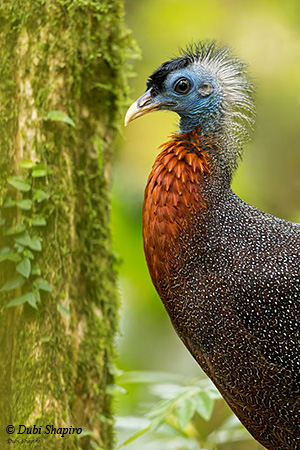
CALLS AND SONGS: SOUNDS BY XENO-CANTO
The Great Argus is a solitary forest-dwelling species.
It has two advertising calls, both of low frequency. These calls are usually given from near the top of low hills. They can be heard as much as a kilometre away, and are among the most evocative sounds of the SW Asian rainforest.
While on the display area, the male utters a loud, bysyllabic “kwow-wow” repeated up to 12 times, most frequently during the breeding season. This call is also given when the bird rests at the nocturnal roosting site.
The second call is a long series of “wow” calls (up to 70 notes and more), starting as descending sounds before rising towards the end while becoming upslurred notes. The female also produces this call.
In solitary species like the Great Argus, the vocal communication is mainly used by the males, especially during the breeding season. Loud calls and quiet sounds are given during close contact in courtship display to females, and in aggressive encounters with rival males.
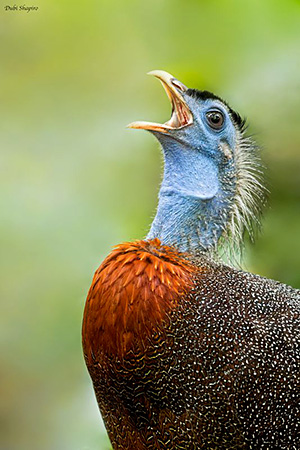
BEHAVIOUR IN THE WILD:
The Great Argus feeds on the forest floor, usually in the early morning and the evening.
The diet includes a variety of plant and invertebrates remains, especially arthropods, and also fruits and seeds. The vegetal food includes fruits of Palmae, Annonaceae and Leguminosae, also climbing and understorey plant species and leafy material. Ants are frequently eaten, and mainly Camponatus gigas.
The Great Argus forages alone. It walks slowly while searching for food among the dead leaves. It also scratches at the litter surface and may also pick fruits still on trees.
They forage on the ground during the day, and roost in trees at night.
Despite being less colourful than other Phasianidae, the Great Argus is known for its spectacular courtship displays.
First, the male prepares and cleans an open area within the forest, which will be used as arena or dancing area.

The display begins when a female, attracted by the loud calls of the male, enters the arena, a patch of up to 72 m².
The male circles the female, coming closer and closer, and suddenly, it thrusts its spread wings and inverts them. During this display, the primaries are spread forwards and touch the ground. The inner secondaries meet at the top, forming a large funnel that enhances the ocelli of the feathers.
While head and neck are hidden, the male’s eyes are staring at the female. It waggles the tail back and forth and vibrates its plumage, producing a rustling sound.
After successful courtship display, the female alone will perform the nesting duties. The species is monogamous.
The Great Argus is sedentary.
The flight is usually restricted to short, strong bursts, and short periods of rapid wing-flapping.

REPRODUCTION OF THIS SPECIES:
The breeding season varies depending on the range, but also within and between years.
The Great Argus is solitary nester and territorial. The species is monogamous.
The female builds the nest, a hollow lined with dead grass stems and placed between the buttresses of a tree.
A second nest was found, built within the litter-filled depression of a tree stump, 1,5 metre above the ground.
She lays two creamy-white to pale reddish-buff eggs, with brown markings. She incubates alone during 24-25 days (in captivity). The chicks are covered with rufous-chestnut down, usually dark above and paler below.
She performs alone all the nesting duties.
PROTECTION / THREATS / STATUS:
The Great Argus is threatened by degradation and fragmentation of the habitat, caused by logging and land conversion, including inside protected areas.
Forest fires frequency is increasing across the formerly intact forest.
Expansion of oil palm plantations involves forest clearance.
In Sumatra, less than 13% of the original lowland forest remains.
Logging involves the reduction of the Great Argus density. The rapid loss of the forest has fragmented many regions in which the species cannot persist, or only at much reduced densities.
Another problem is the cage-bird industry, especially for the sale of feathers, but also for ceremonial decoration. The Great Argus is also hunted for food.
The global population has been estimated to number more than 100,000 individuals, but it is suspected to be declining slowly, owing to hunting and habitat loss.
The Great Argus is currently listed as Vulnerable.
